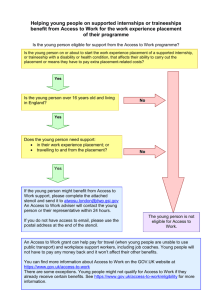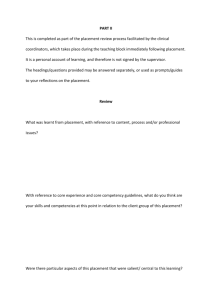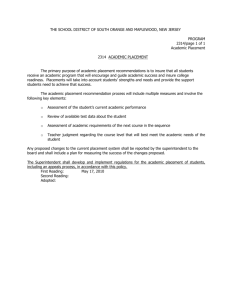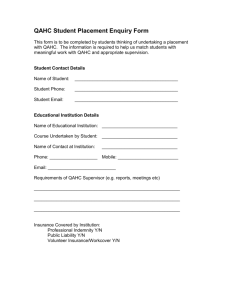Placement Forms - Griffith University
advertisement
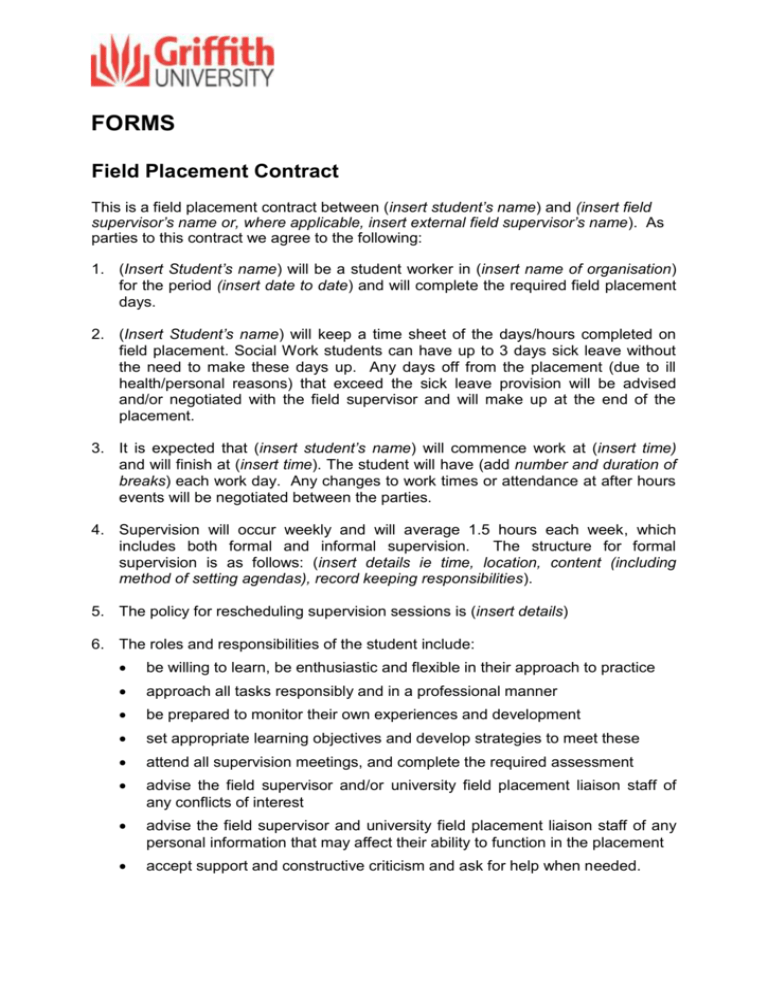
FORMS Field Placement Contract This is a field placement contract between (insert student’s name) and (insert field supervisor’s name or, where applicable, insert external field supervisor’s name). As parties to this contract we agree to the following: 1. (Insert Student’s name) will be a student worker in (insert name of organisation) for the period (insert date to date) and will complete the required field placement days. 2. (Insert Student’s name) will keep a time sheet of the days/hours completed on field placement. Social Work students can have up to 3 days sick leave without the need to make these days up. Any days off from the placement (due to ill health/personal reasons) that exceed the sick leave provision will be advised and/or negotiated with the field supervisor and will make up at the end of the placement. 3. It is expected that (insert student’s name) will commence work at (insert time) and will finish at (insert time). The student will have (add number and duration of breaks) each work day. Any changes to work times or attendance at after hours events will be negotiated between the parties. 4. Supervision will occur weekly and will average 1.5 hours each week, which includes both formal and informal supervision. The structure for formal supervision is as follows: (insert details ie time, location, content (including method of setting agendas), record keeping responsibilities). 5. The policy for rescheduling supervision sessions is (insert details) 6. The roles and responsibilities of the student include: be willing to learn, be enthusiastic and flexible in their approach to practice approach all tasks responsibly and in a professional manner be prepared to monitor their own experiences and development set appropriate learning objectives and develop strategies to meet these attend all supervision meetings, and complete the required assessment advise the field supervisor and/or university field placement liaison staff of any conflicts of interest advise the field supervisor and university field placement liaison staff of any personal information that may affect their ability to function in the placement accept support and constructive criticism and ask for help when needed. 7. The roles and responsibilities of the field supervisor include (adjust as necessary and include arrangements for on-site, external or co-supervision arrangements): orientation, monitoring, supervision and evaluation of the student. preparing the organisation for the student’s arrival assisting the student to develop their learning contract and facilitating access to appropriate tasks to meet the learning needs of the student introducing the student to the broader contexts of practice including other organisations, key sector stakeholders, relevant policies and legislation etc mentoring, supporting, challenging and debriefing the student regular weekly supervisory meetings with the student and provision of guidance and support as required liaising with the University field placement liaison staff and reporting any issues regarding the student completion of the mid placement and end of placement evaluation reports. 8. Organisation requirements include: (insert details e.g. police check, compliance with code of conduct, maintenance of records, oaths of confidentiality). 9. Either party should contact the University field placement liaison staff and/or the Field Placement Convenor if issues regarding conduct or performance arise. Signed (Onsite Field Supervisor) ……………………………………………………….. Date………………. Signed (External Supervisor - if applicable) ……………………………………………… Date………………. Signed (Student)…………………………………….…………...... Date…………….. Please complete and student to submit via Learning@Griffith Blackboard course site: Time sheet for field placement Student’s Name: Student Number: Course Code: Must be submitted Friday of final placement week (with assessment items) Week Ending Monday Tuesday Wednesday Thursday Friday Field Supervisor confirmation of field placement days Signature:_________________________________ YES Student’s Signature NO (Please Date:__________________ Supervisor’s Signature circle) Mid Placement Field Report Field Supervisor’s Mid Placement Field Report Social Work Field Placement Course Code (please tick one): Bachelor of Social Work Field Placement 1 (3112HSV_Y2) Bachelor of Social Work Field Placement 2 (4112HSV_Y2) Master of Social Work Field Placement 1 (7134HSV_Y2) Master of Social Work Field Placement 2 (7144HSV_Y2) STUDENT NAME Student No. Placement Start Date End Date SUPERVISORS Field/Agency Supervisor External Supervisor (delete if not applicable) ORGANISATION Name Position Title Email Phone Number Name Email Phone Number Name Program/Team (if applicable) Address Phone and Fax Briefly outline the experiences and tasks performed by the student ______________________________ ______________________________ Field Supervisor’s Signature External Supervisor’s Signature (if applicable) ________ / _________ / ________ ________ / _________ / ________ Date Date End of Placement Field Report Field Supervisor’s End of Placement Field Report Social Work Field Placement Course Code (please tick one): Bachelor of Social Work Field Placement 1 (3112HSV_Y2) Bachelor of Social Work Field Placement 2 (4112HSV_Y2) Master of Social Work Field Placement 1 (7134HSV_Y2) Master of Social Work Field Placement 2 (7144HSV_Y2) STUDENT NAME Student No. Placement Start Date End Date SUPERVISORS Field/Agency Supervisor External Supervisor (delete if not applicable) ORGANISATION Name Position Title Email Phone Number Name Email Phone Number Name Program/Team (if applicable) Address Phone and Fax Briefly outline the experiences and tasks performed by the student *** End of Placement Evaluation Report *** Has the student completed their required minimum number placement days? (1 day = 7 hours + breaks) (1st placement: 68 days, 2nd placement: 72 Days) YES ______________________________ ______________________________ Field Supervisor’s Signature External Supervisor’s Signature (if applicable) ________ / _________ / ________ ________ / _________ / ________ Date Date NO Definition of Scale We expect students to be assessed against all learning outcomes over the course of the placement. Please use the following definition of scale to guide your assessment of the student. Not Competent (NC) Needs Improvement (NI) Competent (C) Exceeds Expectations (EE) Outstanding (O) Not Yet Assessed (NYA) Not Competent (NC): The student is unable to articulate and/or demonstrate the required learning outcome and lacks capacity for improvement at this time. Needs improvement (NI): The student has some difficulty articulating and/or demonstrating the required learning outcome but shows some capacity for improvement. Competent (C): The student is able to articulate and/or demonstrate the required learning outcome most of the time. Exceeds expectation (EE): The student consistently articulates and/or demonstrates the required learning outcome. Outstanding (O): The student is exceptional at articulating and/or demonstrating the required learning outcome, is self-motivated and takes initiative. Not Yet Assessed (NYA): The student has not had the opportunity at this time to complete tasks relating to the learning outcome, therefore an assessment is pending. This scale item can only be used at midplacement. Learning Category 1 : The social work role The student's knowledge of the role and function of social work in their practice agency, community and wider society is applied to identify inequalities and injustices, promote social change and enhance well being. Learning Outcome 1st Placement: The student is able to articulate the purpose of social work in society, identifying underlying aims, objectives and values that inform the social work role. 2nd Placement: The student is able to make links between the purpose of the social work role in society, in the community and within their practice agency 1st Placement: The student is able to demonstrate understanding of the impact of socio-political, economic and environmental factors on individuals, communities and groups in terms of access to services, social justice and distribution of resources to meet needs. 2nd Placement: The student is able to critically evaluate how social work functions in the contemporary Australian welfare system, providing examples of issues facing individuals and groups which impact on well being. 1st Placement: The student is able to articulate their understanding of organizational systems and processes in the placement organization, with respect to power, disadvantage and socio-political factors, that affect, or have potential to affect, the well being of clients. 2nd Placement: The student is able to critically analyse organisational systems to identify changes in social work processes within their placement agency, with respect to power, disadvantage and socio-political factors, that may improve client well being. 1st Placement: The student is able to describe the impact of discrimination, disadvantage and oppression and identify how appropriate change might be achieved. 2nd Placement: The student is able to challenge and address identified discrimination, disadvantage and oppression by participating in the change process where appropriate. Supervisor Comments: NC NI C EE O NYA Learning Category 2 : Ethics and values The student's knowledge of social work ethics and values guides professional practice, ensuring they are able to practice within the values, principles and ethical guidelines of contemporary social work practice. Learning Outcome 1st Placement: The student is able to demonstrate knowledge of their personal value system, identifying key values that influence their professional decision making processes. 2nd Placement: The student is able to critically reflect on how their value system relates to that of the social work value base, identifying any potential conflicts between personal and professional values. 1st Placement: The student is able to demonstrate familiarity with the AASW Code of Ethics, articulating and applying the core values of the profession and key components of ethical social work practice. 2nd Placement: The student is able to demonstrate application of the AASW Code of Ethics within their placement organization, and undertake ethical decision-making processes. 1st Placement: The student is able to identify and discuss value positions of colleagues from other professional disciplines. 2nd Placement: The student is able to critically reflect on the similarities and differences between the value positions of different professional disciplines within the interprofessional context. 1st Placement: The student is able to demonstrate understanding of culture, equity and diversity and their impact on clients in their placement agency, demonstrating culturally competent social work practice. 2nd Placement: The student is able to critically reflect on their practice in relation to cultural competence within their placement agency. 1st Placement: The student is able to identify and comply with additional organizational documents that outline ethical requirements for work within the organization. 2nd Placement: The student is able to critically analyse the relationship between the social work Code of Ethics and ethical documents of the placement agency, identifying any competing requirements or areas of ethical risk. Supervisor Comments: NC NI C EE O NYA Learning Category 3 : Organizational Processes Organizational goals of the service are met by the student, who undertakes work processes appropriately using social work knowledge and skills. Learning Outcome 1st Placement: The student works within the guidelines of agency policies and procedures and demonstrates knowledge of relevant legislative and social policy mandates that inform practice in the agency. 2nd Placement: The student is able to critically analyze organizational systems and processes and the extent to which these are responsive to client need. 1st Placement: The student demonstrates accountability and responsibility, takes initiative for workload, displays appropriate time management skills, punctuality and a professional manner. 2nd Placement: The student demonstrates initiative in managing workload and seeks out opportunities to participate and contribute to all aspects of professional practice within the agency. 1st Placement: The student is able to utilize oral and written communication skills and active listening skills that are in accordance with agency requirements, for example report writing, data collection and recording. 2nd Placement: The student is able to effectively advocate for clients in oral and written communication within the agency, engaging the client where possible. 1st Placement: The student demonstrates effective teamwork, networking and collaboration with workers in the organisation and in other agencies. 2nd Placement: The student effectively represents the social work perspective in team collaborations, demonstrating conflict management and problem solving skills. Supervisor Comments: NC NI C EE O NYA Learning Category 4 : Social work processes Through effective use of the social work skills of engagement, assessment, planning, intervention and review, the student develops the potential of clients, fostering client self-determination and seeking to enhance client well-being. Learning Outcome 1st Placement: The student is able to articulate and demonstrate knowledge of relevant theories, perspectives and models and how they apply to the stages of the social work process. 2nd Placement: The student is able to develop specialist knowledge of social work theories, perspectives, models and the current evidence base which are particularly relevant to the placement agency. 1st Placement: The student is able to purposely and effectively build rapport and engage with clients, in a professional and contextually appropriate way. 2nd Placement: The student can articulate and demonstrate a range of engagement strategies that are specifically tailored to effectively build rapport, demonstrating skills in client centred practice. 1st Placement: The student is able to effectively understand the service user perspective, and seeks to enhance client selfdetermination in a manner consistent with social work aims. 2nd Placement: The student is able to take action to promote the service user’s perspective through the use of skills in advocacy, mediation and conflict resolution. 1st Placement: With support, the student is able to gather, analyze, evaluate and use information and knowledge during an assessment process, seeking out client strengths, resources, limitations and risks accurately. 2nd Placement: The student can independently gather, analyze, evaluate and use information and knowledge during an assessment process, seeking out client strengths, resources, limitations and risks accurately. 1st Placement: With support, the student is able to make decisions and recommendations regarding appropriate planning and intervention, based on the assessment, professional knowledge and judgement and seeks to advance client self determination where possible during this process. 2nd Placement: The student is able to critically analyze the role of power, disadvantage and socio-political factors that may impede the planning and intervention process. 1st Placement: With support, the student can review the social work process, in relation to the effectiveness of the engagement, assessment and intervention process. 2nd Placement: The student is able to critically analyze factors that may have impacted on the social work process, and uses this analysis to inform their future social work process. NC NI C EE O NYA Supervisor Comments: Learning Category 5 : Student Learning and professional development Through a process of critical reflection, the student builds self awareness and is able to use this awareness to inform professional development in such a way that a sustainable social work practice is developed. Learning Outcome 1st Placement: The student is able to demonstrate their development of an emerging practice framework, identifying key components in their approach to social work practice and underlying values that influence their framework for practice. 2nd Placement: The student is able to clearly articulate their beginning practice framework, and critically analyse their own practice approach through continued engagement with the broader social work profession. 1st Placement: The student demonstrates use of self, combining their professional knowledge, skills and values with aspects of their personal self in a purposive manner. 2nd Placement: The student is able to critically reflect on their use of self, identifying areas for improvement and taking action to enhance purposive use of self. 1st Placement: The student is able to articulate the importance of self-care, demonstrating an understanding of how their own health and well being contributes to their professional practice. 2nd Placement: The student has developed strategies for attending to their self-care, and is able to maintain their health and well being through a range of activities. 1st Placement: The student demonstrates a commitment to ongoing learning, using the supervisory process to develop their skills and knowledge. 2nd Placement: The student keeps up to date with the latest research and knowledge, demonstrating a commitment to a life long learning process. 1st Placement: The student demonstrates continual reflection on practice, utilising the supervisory relationship well to identify areas for improvement and development and uses this knowledge to expand their skills. 2nd Placement: The student practices reflectively and reflexively, using the supervision process to develop insight and recognizes and responds in a flexible way to changing practice contexts and environments. Supervisor Comments: NC NI C EE O NYA Summary / Additional comments Overall Performance NC NI C EE O How do you rate this student’s overall performance? End of Placement Field Supervisor Recommendation Pass Fail Do you recommend this student pass Social Work Field Placement? *** Please attach the completed and signed timesheet to your Final Report *** Practice Reflections Students are expected to submit their Weekly Evaluation to their Field Supervisor each week for use and review in supervision. Please confirm that you received and reviewed the evaluations below: WEEK Practice Reflection 1 Practice Reflection 2 Practice Reflection 3 Practice Reflection 4 Practice Reflection 5 Practice Reflection 6 Practice Reflection 7 Practice Reflection 8 Practice Reflection 9 Weekly Evaluation 10 Practice Reflection 11 Practice Reflection 12 Practice Reflection 13 Practice Reflection 14 Practice Reflection 15 Practice Reflection 16 Practice Reflection 17 Practice Reflection 18 YES NO Student’s Personal Evaluation of Field Placement Learning Field Supervisor Evaluation of the University A. How would you rate the support from the University? US Please include any feedback: B. Was the Field Placement Manual: Helpful Not helpful No time to read it properly Please include any feedback: C. Were the University expectations for the placement within your organisation: Reasonable Unreasonable D. Do you have any additional feedback? S HS Glossary Advocate Advocating for a person ‘refers to the activities associated with negotiating or representing on behalf of a person’ (Burke & Dalrymple, 2009, p. 265). Articulate The ability to express an idea or feeling fluently and coherently. Client Clients are individuals, families and other kinship arrangements, groups, communities, organisations and societies (AASW, 2010). Client centred practice Practice informed by the belief that the client is ‘the expert and free to determine their chosen path and the outcomes they encounter’ (Murphy, Duggan & Joseph, 2012, p. 3). Client self determination Self determination involves the social worker promoting the autonomy of clients and ‘actively seeking to enable them to make informed decisions on their own behalf’ (AASW, 2010, p. 25). Critically reflect, evaluate and analyse ‘Critical reflection is most simply understood as an approach to analyzing practice or experience, based on the identification of the assumptions embedded in that practice or experience’ (Fook, 2004, p. 17). Culturally competent practice ‘Cultural competence can be achieved through a commitment to achieving culturally appropriate service delivery and a culturally appropriate workplace environment. This commitment would require a focus on systemic, organisational, professional and individual levels’ (Farrelly & Lumby, 2009, p. 17). Demonstrate The ability to clearly show the existence of a skill or knowledge by giving an exhibition of how the skill or knowledge is applied in practice. Ethics ‘Ethics is a branch of philosophy which addresses questions about morality, such as what is the fundamental nature of morality and the way in which moral values are determined’ (Gray & Webb, 2010, p. 1). Ethical decision making processes ‘Ethical decision making is the process by which social workers engage in an exploration of values, that may be evident in the personal, professional, social and organisational fields, in order to establish where an ethical dilemma might lie according to what competing principles, and what factors take priority in weighing up the alternatives’ (McAuliffe, 2010, p. 41). Initiative The ability to initiate actions or plans independently and to act or make change before others do. Interprofessional Practice Health and community service professionals working together, using complementary knowledge and skills, to provide care to patients, clients and communities, based on trust, respect and an understanding of each other’s expertise. (Griffith University) Practice framework A practice framework is based on a range of knowledge, values and skills that provide a foundation for practice. Frameworks guide practice and make it purposeful, helping the practitioner to make judgements and decisions about how to undertake the work (Chenoweth & McAuliffe, 2012). Professional integrity ‘The social work profession values honesty, transparency, reliability, empathy, reflective selfawareness, discernment, competence and commitment (AASW, 2010, p. 13). Reflective practice ‘Reflection is the process of learning from experience. It involves the process of questioning the foundation of one’s beliefs with a preparedness to change them in the light of questioning’ (Fook, 2013, p. 3). Reflexive practice ‘Reflexivity is an acknowledgement of how our self plays a role in the knowledge that we recognise and develop; in short, how we see the world, others and our place in relation to it and them. Being reflexive involves the ability to factor this knowledge into how professional decisions are made and acted upon’ (Fook, 2013, p. 3). Respect for persons ‘The social work profession holds that every human being has a unique and inherent equal worth and that each person has a right to wellbeing, self-fulfulment and self-determination, consistent with the rights and culture of others and a sustainable environment’ (AASW, 2010, p. 12). Social justice ‘Social justice refers to the concept of a society in which justice is achieved in every aspect of society, rather than merely through the administration of law. It is generally considered as a social world that affords individuals and groups fair treatment, equality and an impartial share of the benefits of membership of society (Ife, 2010, p. 148). Theories, perspectives and Models ‘Theories are ways of viewing the world and explaining how objects, peoples and situations work’ (Howe, 2009, p. 171). ‘A perspective is a particular way of looking at the world, a conceptual lens through which a person views human behaviour and social structure’ (Chenoweth & McAuliffe, 2012, p. 115). ‘A model is a descriptive way of showing the relationship between numbers of elements. Models are often used to outline practice approaches such as crisis intervention or task-centred intervention’ (Chenoweth & McAuliffe, 2012, p. 114). Use of Self ‘The use of self in social work practice is the combining of knowledge, values, and skills gained in social work education with aspects of one’s personal self, including personality traits, belief systems, life experiences, and cultural heritage’ (Walters, n.d.). Values ‘Professional values are a particular grouping and ordering of values within a professional context. In social work such values tend to focus on human functioning, capabilities and development’ (Congress, 2010, p. 19). University Liaison Feedback form Social Work Field Placement University Liaison Feedback form Course Code (please tick one): Bachelor of Social Work Field Placement 1 (3112HSV_Y2) Bachelor of Social Work Field Placement 2 (4112HSV_Y2) Master of Social Work Field Placement 1 (7134HSV_Y2) Master of Social Work Field Placement 2 (7144HSV_Y2) DATE OF VISIT VISIT NO. PLACEMENT WEEK Student Field Supervisor/s University Liaison Organisation Team/Program LEARNING PLAN VISIT 1 The University Liaison will have reviewed the Learning Plan and provided constructive verbal or written feedback to the student during Liaison Visit No. 1. Please provide general comments about the Learning Plan below. VISIT 2 Is the Learning Plan being utilised as a working document? Please provide general comments about any new learning goals set since the first visit and any specific learning strategies set from the mid placement evaluation. PRACTICE REFLECTIONS VISIT 1&2 The Student should be submitting Practice Reflections to their Field Supervisor for discussion in supervision each week. Please provide general comments about the Practice Reflections. SUPERVISION VISIT 1&2 The Student should be engaged in 1.5 hours of supervision for every 5 days of placement. Please provide general comments about the supervision relationship frequency and type (e.g. individual and/or group). GENERAL DISCUSSION ON THE PLACEMENT EXPERIENCE VISIT 1 Feedback from Student and Field Supervisor regarding beginnings, relationships, workload, key learning experiences and key challenges to date. VISIT 2 Feedback from Student and Field Supervisor regarding relationships, workload, key learning experiences to date, strengths and challenges, and the Mid Placement Evaluation experience. ISSUES/CONCERNS Please return to the Field Placement Convenor within 1 week of the visit. Bachelor of Social Work: (3112HSV_Y2 and 4112HSV_Y2): Dr Phyllis Chee Bachelor of Social Work Field Placement Convenor, Logan campus Email: p.chee@griffith.edu.au T: (07) 3382 1484 F: (07) 3382 1210 Ms Janis Parrish Bachelor of Social Work Field Placement Convenor, Gold Coast campus Email: j.parrish@griffith.edu.au T: (07) 5552 8090 F: (07) 5552 8562 Master of Social Work: (7134HSV_Y2 and 7144HSV_Y2): Ms Melanie Hemy Master of Social Work Field Placement Convenor, External Email: m.hemy@griffith.edu.au T: (07) 3382 1195 F: (07) 3382 1210 Dr Jeanette Neden Director of Field Education and Field Placement Convenor, Gold Coast campus Email: j.neden@griffith.edu.au T: (07) 5552 7877 F: (07) 5552 8562 LEARNING PLAN: LEARNING CATEGORY 1 - THE SOCIAL WORK ROLE Goals Objectives Tasks and Methods to achieve the objectives Evidence & Evaluations Time frame LEARNING PLAN: LEARNING CATEGORY 2 - ETHICS AND VALUES Goals Objectives Tasks and Methods to achieve the objectives Evidence & Evaluations Time frame LEARNING PLAN: LEARNING CATEGORY 3 - ORGANISATIONAL PROCESSES Goals Objectives Tasks and Methods to achieve the objectives Evidence & Evaluations Time frame LEARNING PLAN: LEARNING CATEGORY 4 - SOCIAL WORK PROCESSES Goals Objectives Tasks and Methods to achieve the objectives Evidence & Evaluations Time frame LEARNING PLAN: LEARNING CATEGORY 5 - STUDENT LEARNING AND PROFESSIONAL DEVELOPMENT Goals Objectives Tasks and Methods to achieve the objectives Evidence & Evaluations Time frame PROCESS RECORDING Process Recording Outline The following paragraphs provide an explanation of each item that appears in section II of the process recoding outline. INTERVIEW CONTENT: Record in this section, using a dialogue format, significant ongoing exchanges that you thought were important in your interaction with the client(s). DESCRIBE CLIENTS FEELINGS/AFFECT: Record how you perceived the client(s) was feeling moment-to-moment as the activity or verbal interchange was taking place. DESCRIBE YOUR GUT LEVEL FEELINGS: Record how you were feeling as the activity or verbal interchange was taking place. Do not use this column to analyze the client’s reactions –use it to identify and look at your feelings. Be as open and honest as you can and don’t worry about having to use any special professional language-tell it as you feel it. WHAT INTERVIEWING SKILLS DID YOU USE DURING THIS INTERACTION: Label the interviewing skills you used in your interaction with the client(s) (e.g. exploration, summarization, clarification, etc) Draw on skills learnt in counseling and interpersonal skills courses. SUPERVISORY COMMENTS: The supervisor will use this section to provide written commentary and feedback on your interactions with the client(s) in order to help you move towards greater proficiency in your knowledge, skills, and planning. PROCESS RECORDING OUTLINE Student's Name:_____________________________ Client's Initials:________________________________ Interview Date:___/___/____ Session#:_________ Clients Age:__________________________________ Date Submitted:___/___/___ Date Reviewed Clients Ethnicity:______________________________ Date Supervision: ___/___/___ I. PURPOSE OF THE SESSION: (Clearly state the goals and objectives you had in meeting with this client this session.) II. Interview Log: INTERVIEW CONTENT (may also include Client Behavior - i.e. non-verbal communication) DESCRIBE CLIENTS FEELINGS/AFFECT DESCRIBE YOUR GUT LEVEL FEELINGS WHAT INTERVIEWING SKILLS DID YOU USE DURING THIS INTERACTION? SUPERVISORY COMMENTS *Refer to first page for category instructions 35


